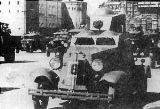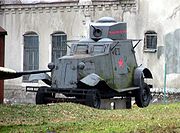
FAI armoured car
Encyclopedia
The FAI armoured car was a replacement for the D-8 armoured car, used by the Soviet Union
from the early 1930s to early 1940s.
 The FAI was built on the chassis of the GAZ
The FAI was built on the chassis of the GAZ
A car, a licensed copy of the US Ford A
. This chassis was the major weakness of the FAI. Most commercial car chassis were not powerful enough to move a useful amount of armour
or fire power
on the battlefield. The Germans were known to get round this particular problem by designing a car chassis that was intended from the outset for both civilian and military vehicles and which was used successfully in at least one German armoured car family of this period. However, armoured cars based on commercial car chassis
were for the most part, road-bound, thinly armoured and lightly armed. The FAI was a typical example of this class of vehicle with a single 7.62 mm DT
machine-gun in a revolving turret. The armour was sufficient to stop most shell fragments and small arms fire, but could not withstand any kind of cannon or heavy machine-gun fire. It was also very vulnerable to mines.
The FAI was built in relatively small numbers before being replaced by the very similar BA-20
. The early BA-20 had the same vertically sided turret as the FAI. FAIs were employed in the early days of fighting on the Eastern Front
in World War II
. The Germans used some captured vehicles of this type, at least one of which was taken over by Polish forces during the Warsaw uprising.
The FAI and BA-20 series had a few advanced features. They were of all-welded construction in an era when very few AFVs were welded. Also, they had cork-filled tires to enable them to retain mobility even if the tires were penetrated.
The FAI and BA-20 are often mistaken for each other. The main recognition feature of the FAI is the two dome-shaped armoured covers over the driver and co-driver's stations. The BA-20 had a flat armoured roof in this area instead.
Soviet Union
The Soviet Union , officially the Union of Soviet Socialist Republics , was a constitutionally socialist state that existed in Eurasia between 1922 and 1991....
from the early 1930s to early 1940s.

GAZ
GAZ or Gorkovsky Avtomobilny Zavod , translated as Gorky Automobile Plant , started in 1932 as NAZ, a cooperation between Ford and the Soviet Union. It is one of the largest companies in the Russian automotive industry....
A car, a licensed copy of the US Ford A
Ford Model A (1927)
The Ford Model A of 1927–1931 was the second huge success for the Ford Motor Company, after its predecessor, the Model T. First produced on October 20, 1927, but not sold until December 2, it replaced the venerable Model T, which had been produced for 18 years...
. This chassis was the major weakness of the FAI. Most commercial car chassis were not powerful enough to move a useful amount of armour
Armour
Armour or armor is protective covering used to prevent damage from being inflicted to an object, individual or a vehicle through use of direct contact weapons or projectiles, usually during combat, or from damage caused by a potentially dangerous environment or action...
or fire power
Fire power
Firepower is the military capability to direct force at an enemy. It is not to be confused with the concept of rate of fire, which describes cycling of the firing mechanism in a weapon system. It involves the whole range of potential weapons...
on the battlefield. The Germans were known to get round this particular problem by designing a car chassis that was intended from the outset for both civilian and military vehicles and which was used successfully in at least one German armoured car family of this period. However, armoured cars based on commercial car chassis
Chassis
A chassis consists of an internal framework that supports a man-made object. It is analogous to an animal's skeleton. An example of a chassis is the underpart of a motor vehicle, consisting of the frame with the wheels and machinery.- Vehicles :In the case of vehicles, the term chassis means the...
were for the most part, road-bound, thinly armoured and lightly armed. The FAI was a typical example of this class of vehicle with a single 7.62 mm DT
Degtyarev light machine gun
The Пулемёт Дегтярёвa Пехотный or DP was a light machine gun firing the 7.62x54mmR cartridge that was used by the Soviet Union starting in 1928. It was cheap and easy to manufacture - early models had fewer than 80 parts and could be built by unskilled labour. The DP was especially able to...
machine-gun in a revolving turret. The armour was sufficient to stop most shell fragments and small arms fire, but could not withstand any kind of cannon or heavy machine-gun fire. It was also very vulnerable to mines.
The FAI was built in relatively small numbers before being replaced by the very similar BA-20
BA-20
The BA-20 was an armored car developed in the Soviet Union in 1936 and used in the early stages of World War II.-Design and production:The BA-20 armored car was developed in 1934 for use by HQ staffs, reconnaissance and communications units...
. The early BA-20 had the same vertically sided turret as the FAI. FAIs were employed in the early days of fighting on the Eastern Front
Eastern Front (World War II)
The Eastern Front of World War II was a theatre of World War II between the European Axis powers and co-belligerent Finland against the Soviet Union, Poland, and some other Allies which encompassed Northern, Southern and Eastern Europe from 22 June 1941 to 9 May 1945...
in World War II
World War II
World War II, or the Second World War , was a global conflict lasting from 1939 to 1945, involving most of the world's nations—including all of the great powers—eventually forming two opposing military alliances: the Allies and the Axis...
. The Germans used some captured vehicles of this type, at least one of which was taken over by Polish forces during the Warsaw uprising.
The FAI and BA-20 series had a few advanced features. They were of all-welded construction in an era when very few AFVs were welded. Also, they had cork-filled tires to enable them to retain mobility even if the tires were penetrated.
The FAI and BA-20 are often mistaken for each other. The main recognition feature of the FAI is the two dome-shaped armoured covers over the driver and co-driver's stations. The BA-20 had a flat armoured roof in this area instead.
External links
- FAI at Battlefield.ru
- U.S. WWII Newsmap, "Russian Armored Vehicles", hosted by the UNT Libraries Digital Collections

